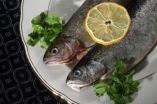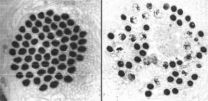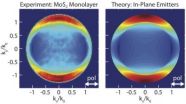(Press-News.org) TAMPA, Fla. (March 5, 2013) – Chemists at the University of South Florida and King Abdullah University of Science and Technology have discovered a more efficient, less expensive and reusable material for carbon dioxide (CO2) capture and separation. The breakthrough could have implications for a new generation of clean-air technologies and offers new tools for confronting the world's challenges in controlling carbon.
Publishing this month in the journal Nature, the international group of scientists has identified a previously underused material – known as SIFSIX-1-Cu - that offers a highly efficient mechanism for capturing CO₂.
The discovery represents more than an improvement over existing materials in terms of carbon capture, said USF Chemistry Professor Mike Zaworotko, noting that the material also is highly-effective at carbon capture even in the presence of water vapor, a standard that other materials have not been able to meet. This makes it a promising candidate for real-world applications. Water normally interferes with CO₂ capture, but the material developed in the USF-KAUST project resists it.
"I hate to use the word 'unprecedented' but we have something unprecedented," Zaworotko said. "We sort of hit a sweet spot in terms of properties."
The discovery addresses one the biggest challenges of capturing CO2 before it enters the atmosphere: energy costs associated with the separation and purification of industrial commodities currently consumes around 15 percent of global energy production. The demand for such commodities is projected to triple by 2050, the researchers note.
The problem is pronounced in capturing CO2, which in addition to its notoriety with climate change, is an impurity in natural gas, biogas and other gas streams, they said.
The material is a crystal whose atoms form a three-dimensional lattice with holes that snare molecules of CO2 but allow other molecules in air to pass. SIFSIX-1-Cu is an adaptation of a material created more than 15 years ago and is named after the chemical component that leads to the special properties; its chemical name is hexafluorosilicate.
Porous SIFSIX materials are built from combinations of inorganic and organic chemical building blocks and are part of a general class of materials known as Metal-Organic Materials, or "MOMs".
The breakthrough is several years in the making and began with an undergraduate research project conducted by USF student Stephen Burd under Zaworotko's supervision. Now a graduate student in chemistry, Burd's initial testing of the material and discovery of its high-selectivity for CO2 then grew to involve an international research group involving USF chemists Brian Space, Shengqian Ma, Mohamed Eddaoudi (who is also a faculty member at KAUST) and graduate collaborator Patrick Nugent.
The research facilities at KAUST combined with the multidisciplinary expertise in Eddaoudi's research group – which includes researchers Youssef Belmabkhout, Amy Cairns and Ryan Luebke - allowed the design of unique experiments that permitted the sorption (the physical and chemical process by which substances attach to each other) properties of this class of materials to be unveiled.
To confirm their findings, the researchers used supercomputer simulations in the National Science Foundation's XSEDE network.
"We work with the experimental groups in a back-and-forth process," Space said. "We tried to explain their data, and our results give them hints on how to change the way the material works."
Space's team used several supercomputers in the National Science Foundation's XSEDE network for this work. They initially used Pittsburgh Supercomputing Center's Blacklight to simulate the behavior of small numbers of gas molecules with each other and with the MOM material.
Predicting the exact behavior of even small numbers of molecules requires a huge amount of computer memory — more than one terabyte, greater than the RAM memory in a thousand brand-new iPads. Such calculations are a specialty of Blacklight, the largest "shared memory" computer in the world. The researchers then used the Blacklight results to simulate the behavior of the gasses and the MOMs in bulk on XSEDE computers Ranger, at the Texas Advanced Computing Center, and Trestles, at the San Diego Supercomputer Center.
The group believes the material has three potentially significant applications: carbon-capture for coal-burning energy plants; purification of methane in natural gas wells; and the advancement of clean-coal technology. Some 20 to 30 percent of the power output at a clean-coal plant is consumed by cleaning process. The new material could make those plants more efficient and put more power into the grid, the scientists predict.
The next step is to collaborate with engineers to determine how the materials can be manufactured and implemented for real-world uses.
###
To read the full publication, "Porous materials with optimal adsorption thermodynamics and kinetics for CO2 separations" visit the journal Nature here. END
USF and KAUST chemists develop efficient material for carbon capture
Metal-Organic Framework could produce cheaper tools for cleaner air, energy production
2013-03-05
ELSE PRESS RELEASES FROM THIS DATE:
Gravitational telescope creates space invader mirage
2013-03-05
Abell 68, pictured here in infrared light, is one of these galaxy clusters, and it greatly boosts the power of Hubble, extending the telescope's ability to observe distant and faint objects [1]. The fuzzy collection of blobs in the middle and upper left of the image is a swarm of galaxies, each with hundreds of billions of stars and vast amounts of dark matter.
The effect of this huge concentration of matter is to deform the fabric of spacetime, which in turn distorts the path that light takes when it travels through the cluster. For galaxies that are even further away ...
Health benefits of marriage may not extend to all
2013-03-05
COLUMBUS, Ohio – Marriage may not always be as beneficial to health as experts have led us to believe, according to a new study.
Researchers made two discoveries that explain why: First, marriage provides less protection against mortality as health deteriorates, even though it does seem to benefit those who are in excellent health. Secondly, married people tend to overestimate how healthy they are, compared to others.
"We believe marriage is still good for the health of some people, but it is not equally protective for everyone," said Hui Zheng, lead author of the study ...
Heavy moms-to-be at greater risk of c-section
2013-03-05
Researchers from Norway found that women with a pre-pregnancy body mass index (BMI) of 40 had an increased risk of vacuum extraction delivery or Cesarean section (C-section). Findings that appear in Acta Obstetricia et Gynecologica Scandinavica, a journal published by Wiley on behalf of the Nordic Federation of Societies of Obstetrics and Gynecology, indicate that women with more than a 16 kg (30 lbs) weight gain during pregnancy increased their risk of forceps or vacuum extraction, and C-section.
Obesity is a global health crisis, with the World Health Organization ...
Why fish is so good for you
2013-03-05
Jena (Germany) Fish is healthy: easy to digest and with a high level of precious proteins, fish is considered an important part of a healthy diet. And with the so-called omega-3 fatty acids fish contains real 'fountains of youth'. These fatty acids – like docosahexaeonic acid (DHA) occur mostly in fatty fish like herring, salmon and mackerel. They are thought to lower the blood pressure, to strengthen the immune system and to have positive effects on the development on the nervous system and the cardiovascular system.
"Clinical studies about the intake of nutritional ...
Does the villainous 'selfish' gene undermine genome's police?
2013-03-05
PROVIDENCE, R.I. [Brown University] — For a bunch of inanimate chemical compounds, the nucleic and amino acids caught up in the infamous "selfish" segregation distorter (SD) saga have put on quite a soap opera for biologists since the phenomenon was discovered in fruit flies 50 years ago. A new study, a highlight in the March issue of the journal Genetics, provides the latest plot twist.
In TV listings the series would be described this way: "A gene exploits a rival gene's excesses, sabotaging any sperm that bear the rival's chromosome." The listing is not an exaggeration ...
Colonoscopy screening reduces risk of advanced colorectal cancer
2013-03-05
Philadelphia - A new study led by a researcher at the Perelman School of Medicine at the University of Pennsylvania adds support to current medical recommendations stating that screening colonoscopy substantially reduces an average-risk adult’s likelihood of being diagnosed with advanced colorectal cancer (CRC) in either the right or left side of the colon. In recent years, colonoscopy has begun to rapidly replace sigmoidoscopy – a procedure used to detect abnormalities in the rectum and left side of the colon – despite initially limited evidence of its efficacy and higher ...
New spectroscopy method could lead to better optical devices
2013-03-05
PROVIDENCE, R.I. [Brown University] — A multi-university research team has used a new spectroscopic method to gain a key insight into how light is emitted from layered nanomaterials and other thin films.
The technique, called energy-momentum spectroscopy, enables researchers to look at the light emerging from a thin film and determine whether it is coming from emitters oriented along the plane of the film or from emitters oriented perpendicular to the film. Knowing the orientations of emitters could help engineers make better use of thin-film materials in optical devices ...
Shadows over data sharing
2013-03-05
In a paper about to be published in EPJ Data Science, Barbara Jasny, deputy editor for commentary at Science magazine in Washington, DC, USA, looks at the history of the debates surrounding data access during and after the human genome "war". In this context, she outlines current challenges in accessing information affecting research, particularly with regard to the social sciences, personalised medicine and sustainability.
The trouble is that most researchers do not currently share their data. This is due both to research practices and research culture. Scientists withholding ...
Herbal defluoridation of drinking water
2013-03-05
Researchers in India have developed a filter system based on a medicinal herb, which they say can quickly and easily remove "fluoride" from drinking water. The technology described in the March issue of the International Journal of Environmental Engineering uses parts of the plant Tridax procumbens as a biocarbon filter for the ion.
Drinking water can contain natural fluoride or fluoride might be added as a protective agent for teeth by water companies. However, its presence is not without controversy while in some natural drinking water levels may be above those considered ...
Kirk, Spock together: Putting emotion, logic into computational words
2013-03-05
Kirk and Spock may not need a Vulcan mind meld to share cognition: Virginia Tech Carilion Research Institute scientists have found that our cold reasoning and hot feelings may be more intimately connected than previously thought.
"We tend to believe we have rational parts, like Spock, and separate emotional parts, like Kirk. But our research suggests that's not true," said Read Montague, director of the Human Neuroimaging Laboratory at the Virginia Tech Carilion Research Institute, who led the study. "We're all a combination of logical Spock and intuitive Kirk. Cold ...
LAST 30 PRESS RELEASES:
Why swearing makes you stronger
What prevents more cancer patients from enrolling in potentially life-saving clinical trials?
UK’s worst-case climate risks laid bare for lawmakers
A decline in churchgoing linked to more deaths of despair
TAMEST announces Maralice Conacci-Sorrell, Ph.D., UT Southwestern Medical Center, as 2026 Mary Beth Maddox Award & Lectureship Recipient
Global study to evaluate whether dengue outbreaks can be anticipated earlier
Chonnam National University researchers propose innovative voltage-loop control for power factor correction
Accelerating next-generation drug discovery with click-based construction of PROTACs
Detecting the hidden magnetism of altermagnets
$7M gift supports health research, engineering and athletics at UT San Antonio
NU-9 halts Alzheimer’s disease in animal model before symptoms begin
Hospitals acquired by real estate investment trusts associated with greater risk of bankruptcy, closure
City of Hope scientists study rare disorder to uncover mechanism and hormone regulation underlying fatty liver disease and sweet aversion
Your genes may influence gut microbiome of others, rat study shows
‘Personality test’ shows how AI chatbots mimic human traits – and how they can be manipulated
Global food systems driving twin crises of obesity and global heating
Osaka Medical and Pharmaceutical University researchers capture real-time molecular movies of enzyme catalysis
Could your genes influence the gut microbiome of others?
Clues to Alzheimer’s disease may be hiding in our ‘junk’ DNA
Study reveals that the body uses different sensors to detect cold in the skin and in internal organs
iPS cells from dish to freezer and back
Deep neural networks enable accurate pricing of American options under stochastic volatility
Collective risk resonance in Chinese stock sectors uncovered through higher-order network analysis
Does CPU impact systemic risk contributions of Chinese sectors? Evidence from mixed frequency methods with asymmetric tail long memory
General intelligence framework to predict virus adaptation based on a genome language model
Antibiotic resistance is ancient, ecological, and deeply connected to human activity, new review shows
Vapes, pouches, heated tobacco, shisha, cigarettes: nicotine in all forms is toxic to the heart and blood vessels
From powder to planet: University of Modena engineers forge a low-carbon future for advanced metal manufacturing
Super strain-resistant superconductors
Pre-school health programme does not improve children’s diet or physical activity, prompting call for policy changes, study finds
[Press-News.org] USF and KAUST chemists develop efficient material for carbon captureMetal-Organic Framework could produce cheaper tools for cleaner air, energy production



